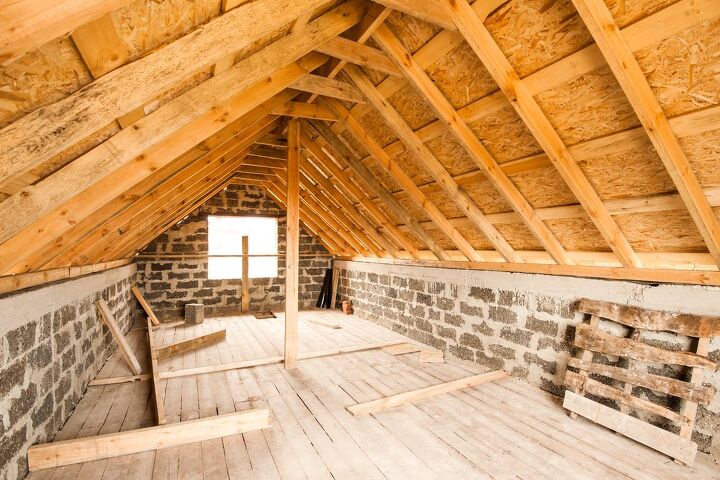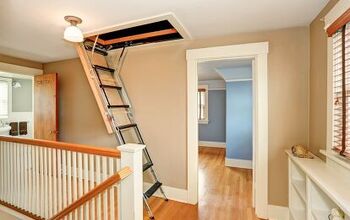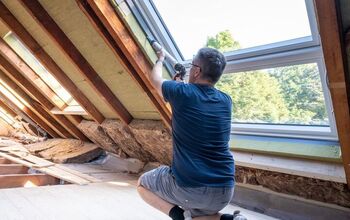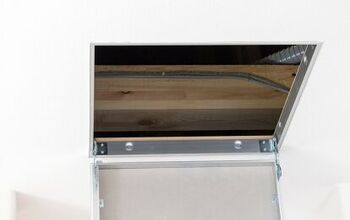What Temperature Should An Attic Be? (Find Out Now!)

Although most homeowners don’t think about them often, an attic is a crucial part of a home. Therefore, if it’s not taken care of properly, then it can increase how much you pay in bills each month or even lead to something more serious like a structural collapse.
When it comes to attics, one of the most important factors to keep in mind is temperature. If you don’t maintain an adequate temperature in your attic, then a slew of negative consequences could be in your future. This article will discuss attic temperature in detail and provide other bits of useful attic-specific information.
First and foremost: an attic should never be more than 130°F. If the temperature exceeds this, then many problems and hazards could be on the horizon. An attic should be no more than 10 to 20° hotter than the outside temperature in the summertime and no less than 60°F in the wintertime.
Do You Need a Heating and Cooling Contractor?
Get free, zero-commitment quotes from pro contractors near you.

The Purpose of an Attic
If your home has a pitched roof, then it most likely has an attic as well. Pitched roofs are common in places that experience snowfall and/or heavy rain, as these roofs distribute weight evenly to ensure they won’t collapse under heavy pressure. In homes that have high ceilings and/or a raised roof, the traditional attic is absent.
The attic is the space directly under the roof, and it’s usually accessible via a pull-down staircase in the home’s highest ceiling (which is also essentially the attic’s floor). Back in the day, when humans were living in log cabins and other primitive structures, attics doubled as bedrooms for a lot of individuals. Nowadays, attics are mainly used as storage space.
If you insulate this space properly, then you can keep it hot or cold (depending on what’s needed at the time). And keep in mind that properly ventilating your attic can help it serve you well for a long time.
For homes that have an attic, the rooms below this space will be cooler in the summertime and warmer in the wintertime. This is because there’s considerable space between these rooms and the outside. In homes where there’s nothing between the main rooms and the roof, it can get quite cold in the winter and real hot in the summer.
What Should the Temperature Be In an Attic?
To be honest, maintaining an ideal temperature in the attic is not the easiest thing to achieve, but this doesn’t mean it’s impossible. Furthermore, it’s something you have to do, for if the temperature isn’t correct, then your house could be at risk and you may be paying more than you have to. Here’s what you need to do in order to get an ideal temperature in your attic.
How Outside Temperature Factors In
It should come as no surprise that the temperature outside plays a big role in determining the temperature of the attic. Therefore, if it’s hot outside—and “hot” here is classified by temperatures of 70°F or greater—then you should make sure your attic does not exceed the outside temperature by 10 to 20°. At the most, an attic can withstand 130°F.
If the temperature in your attic exceeds this recommended range, then numerous bad things can happen, but these will be explained in depth later on. Here, the most important thing to keep in mind is the range of 10 to 20°. As long as you remember this range, you’ll be able to ensure your attic is the right temperature every single day.
But what about when it’s cold outside and the temperature has dropped, perhaps even below 0°? If your attic is consistently below 60° in the wintertime, then you may have a hard time heating your home. Therefore, you should make sure the temperature in the attic is at least mildly warm in the winter, as this will ensure no winter-related problems for your attic, like frozen pipes, leaks, dampness, etc.
Maintaining an Ideal Temperature in the Summertime
When it’s quite hot outside, then it’s likely your attic will be the hottest part of your home. This is especially true if your attic lacks proper ventilation. When there isn’t proper ventilation in your attic, then hot air can become trapped between the insulation and the roof, turning your attic into a large oven.
As was mentioned earlier, an attic’s temperature should never exceed 130°F, and it’s really only in the summertime when this is even a possibility. Here’s what could happen if your attic does exceed this temperature.
Cooling Your Home Will Be Challenging
When your attic is considerably hotter than the rest of your home, cooling the rooms you use most can be difficult. Your HVAC system will have to work a lot harder than it should to cool your home, and such a situation can lead to untimely system failure.
If this happens, then your attic won’t be the only place that’s blisteringly hot, as the rest of your home probably will be as well. The attic is there to ensure that the rooms below have comfortable temperatures year-round, but the attic won’t be able to ensure this if it’s compromised.
Degrading Insulation
When the attic is too hot, the insulation inside it can deteriorate. Insulation, like cellulose, is generally made of recycled materials, and these degrade over time as it is. Extreme heat can speed up the degradation process and reduce the effectiveness of insulation.
Degrading Asphalt Shingles
It was said earlier that an attic helps with keeping the roof in good working order. But if the attic is too hot, then this can cause the asphalt shingles on the roof to degrade quicker than they’re supposed to.
Asphalt shingles have enough to deal with, as they absorb heat from the sun. If they have to absorb trapped heat that’s emanating from the attic below, then they can quickly lose the essential oils that protect them. Once this happens, it’s a only a matter of time before they become totally ineffective.
Mold Growth
One of the worst things one can find in a home is mold. An attic that’s too hot can create the ideal environment for mold, especially when there’s humidity as well. Mold will thrive in this environment and eventually it might spread beyond the attic. In some cases, it can cost thousands of dollars to eliminate mold completely.
Maintaining an Ideal Temperature in the Wintertime
When the temperature outside drops in the wintertime and your attic isn’t prepared for this, then some cold-specific problems could be on the horizon for your home. Of all the parts of your home, the attic will be exposed to cold weather the most. Therefore, if there isn’t proper insulation, then your home will constantly be supplied with a stream of cold air, which means heating the home will be difficult. Here are the common negative consequences of having a cold attic:
Difficulty Making the Home Warmer
Just like in the summertime, an attic will provide a buffer between the outside temperature and the rooms in your home that are used most often. But if your attic is too cold because of ineffective insulation, then this means your home will constantly be cold as well.
Your home’s HVAC system will combat this coldness, but to do so effectively it will have to work round the clock. When an HVAC system has to work continuously harder, then it will experience a lot of strain, and eventually the system may fail prematurely because it was run in this way.
Furthermore, some argue that an HVAC system failure is even more disastrous in the wintertime, as without proper heat you can expect things like frozen pipes and frigid temperatures. Human beings can even succumb to exposure when an HVAC goes out and there’s no way to get warm air in the home in time; just look at what happened in Texas in 2021.
Problems With the Ductwork
There may also be problems with the ductwork if a large segment of it is housed in your attic. When the attic is too cold, the temperature can cool the heated air that’s in the ducts before it has a chance to reach the rest of the home. And when this happens, you can expect to pay much more for energy, as your system will essentially be running continuously.
Ice Dams
An attic that’s too cold can also lead to ice dams on your roof. Ice dams can cause structural damage and can also lead to leaks. If your shingles get water underneath them and this water freezes, the shingles will expand and gaps will be created in the roof. When water enters these gaps, it’ll have a clear route to whatever is below, and often it’s a ceiling that isn’t equipped to deal with leaks from above.
Which Is Worse for Attics: Summertime or Wintertime?
One might be able to say that there’s more at risk with a cold attic than a hot attic, but in either case you don’t want to take any chances. It’s best to ensure your attic is the right temperature year round, and this can be done by taking necessary action when it’s required.
Most of the time, all that’s needed to make an attic sound again is proper insulation. This doesn’t have to be a costly job—you just need to hire the right professional.
Is an Attic Dangerous When It’s Hot?
It’s been explained already how extreme heat can cause problems for a home’s HVAC system, but is an attic that’s too hot dangerous? The short answer is yes. Here are the risks homeowners run when they don’t bother to regulate attic temperature.
Humidity & Mold Growth
As water heats, it evaporates. Sure, outside temperature will most likely never bring water to the point of boiling, but a hot day can definitely cause water to evaporate quicker than it would otherwise.
For this reason, hot days are often associated with high humidity, and it’s this latter factor that can really wreak havoc on an attic in the summertime. When humidity gets trapped in a confined space, like an attic, this can lead to mold growth and a bunch of other negative consequences.
Mold growth is especially prevalent in attics and basements, as both spaces are often damp and lacking ideal ventilation. If there isn’t proper ventilation in your attic, mold will thrive and spread, to the point where it may eat into the structural elements of your home, destroying them.
You’ll have to pay thousands of dollars to get replacement wood and other building materials, but even fixing the most affected areas won’t return your home’s structure to the state of soundness it had before the mold grew.
Fires
Another hazard that’s associated with excessive heat in the attic, though it’s not all that common, is a fire. Homes that are made out of low-quality building materials are at particular risk here, as such homes are usually more flammable while being compromised in other ways as well.
To know whether or not your home is made out of low-quality materials, look around for cracks in walls, structural defects, and problems with the foundation. Another indication is a wet, soggy wall, as behind this are pipes that were probably poorly installed.
The quality of the wood used plays the biggest role in determining flammability, so if your house is made out of dry wood—either because it’s old or that’s just how it was constructed—then excessive heat in the attic could spark a fire, especially if the attic isn’t ventilated the right way.
Specific Fire Risks
If your attic is used as storage space—and you have flammable items up there—then a fire could spark and start a blaze. An attic is one of the worst places for a fire to occur, as it’s cramped, hard to access, and a major component of the home’s structure.
If your attic has an open build, then there will be more ways for moisture and humidity to escape. This is good if you’re trying to ensure you never have to deal with mold and dampness, but keep in mind that such a system can dry out the air in the attic. And if it’s too dry, it can even ignite!
The Importance of Proper Attic Ventilation
It’s been said numerous times by now that an attic requires proper ventilation, but a whole section is necessary to explain why attic ventilation is paramount. Ventilation is arguably the most important factor when it comes to determining temperature in an attic.
Without proper ventilation, air is not able to circulate properly. When this happens, heat and humidity are allowed to stay in the attic for a long time, building up to the point where eventually they become problematic.
Attic Ventilation: New Homes vs. Old Homes
Some attics lack ventilation completely, and such attics are usually found in centuries-old homes. These attics are not going to be addressed here, as most homes being built nowadays utilize proper attic ventilation. The most important thing you should know about ventilation is that it’s completely necessary, whether we’re talking about a building or a home.
If you’re looking to purchase a new home and you haven’t checked to see how well the attic is ventilated, then you need to do this before you sign any paperwork. You could also call a professional to see what they think.
Attic ventilation is something you can pursue as a homeowner, but it might cost you a bit to do this, especially if you have a large home or one that requires complex ventilation. Ventilation will also determine how well hot and cold air stays in your home. Therefore, if your attic can’t keep an internal temperature well, then it’s quite likely you’ll be paying for this via a higher energy bill until the problem is fixed.
How to Get Good Attic Ventilation
When it comes to attic ventilation there are two main ventilation systems: passive ventilation and active ventilation. Both systems are briefly explained below.
Passive Ventilation
Passive ventilation, otherwise known as basic ventilation, is when physics is used to move air around a home. Two things are required to make this happen: intake and exhaust vents.
The intake vents are placed at the lowest parts of an attic, usually under the eaves, as this is where cold air enters the attic. This cold air will then push the hot air, which is in the ducts, out of the upper exhaust vents, and sometimes turbine vents, ridge vents, and roof vents are used to expedite this process.
Passive attic ventilation is ideal because it uses physics to move air inside the attic. There’s no mechanical energy needed and significant human interaction is not required.
Active Ventilation
Active systems utilize fans to speed up the ventilation process. These work faster than passive systems, but that’s really the only benefit. They are pretty much the same as passive systems, except fans push the air quicker than it would go naturally. Here are some things you should know about an active system:
- Electricity will be required to power the fans.
- Generally, the ventilation will need to be replaced every 15 to 20 years.
- Ventilation fans often have thermostats, and these need to be set and maintained.
There are, however, solar-powered ventilation fans, and these self-generate power. They also have built-in thermostats, so they really don’t require a lot of maintenance and work well on their own. If you’re looking to get a solar-powered attic fan, then you should consider this model, as I’ve personally seen it work well and it seems, judging by numerous online reviews, that others find it useful as well.
Combining Passive and Active Systems
Passive and active systems can be combined. Specifically, one can combine a passive intake vent and an active intake fan when they want to bring in cool air. A passive vent, like a ridge vent, can be used with an exhaust fan, like a vent fan, to create a combination that’s ideal for an intricate roof.
Do You Need a Heating and Cooling Contractor?
Get free, zero-commitment quotes from pro contractors near you.

Related Questions
Are active ventilation systems a waste of money?
A lot of homeowners, business owners, and industry experts consider basic active ventilation systems to be a waste of money, as they don’t do much more than passive systems do; unless, of course, you pay for a high-performance system. This is the main reason why passive systems are generally preferred over active ones.
What temperature should an attic fan be set to?
It’s best to get a system that can ensure your attic is cool in the summertime and warm in the wintertime. But the most important thing is that you keep up with the temperature changes and adjust the temperature of your attic accordingly.You don’t have to do this every day, but when the temperature drops or increases 10 degrees, and stays in that range for a few days, then it’s safe to adjust your attic temperature to accommodate this change.
Related Guide

Matt loves everything DIY. He has been learning and practicing different trades since he was a kid, and he's often the first one called when a friend or family member needs a helping hand at home. Matt loves to work with wood and stone, and landscaping is by far his most favorite pastime.
More by Matthew Mountain



























